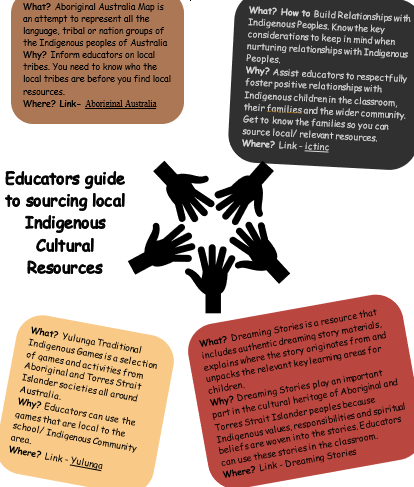3 Useful resources for teachers
Alexandra McLean
This resource is a useful online document/guide informing educators on how to source local Indigenous Cultural Resources through building respectful relationships with local Indigenous community members. It also provides a range of relevant dreaming stories while unpacking their key messages, and traditional Indigenous games that can be used within the classroom. These will support, value and celebrate Indigenous students in the classroom and enable all students to gain understanding of Indigenous cultures. This resource has been created with a brief description of what the resource is and why it is valuable and important for teachers and where to find it (hyperlinked for direct access to each website).
The educators’ concern was that they needed a useful resource to source local Indigenous Cultural Resources such as knowledge and stories. This resource has been based on the IceBerg concept of culture (Hall, 1976). Surface culture concepts, such as traditional games and DreamTime stories are considered, as well as “deep culture” information to assist educators on the appropriate ways to source local Indigenous resources respectfully.
One website focuses on how to form positive relationships with Indigenous peoples. It explains the respectful way to build a strong relationship with Indigenous children in the classroom and their families, considering attitudes towards elders, personal space, rules of conduct, and non-verbal communication. These are important factors to respect and acknowledge when building relationships with local Indigenous peoples. Once a respectful relationship has been formed over time opportunities to gain knowledge of cultures and histories may increase. An effective way to embed Indigenous Culture into the classroom is by getting to know the Indigenous students in the classroom and their families and wider community. It is important to act in a respectful manner in order to create a positive relationship with these students and their families. Furthermore, the Indigenous Map included in the guide exposes educators to a useful tool that acknowledges First Nations’ lands and traditional custodians of country.
Links
Early Years Learning Framework (DEEWR, 2009)
- Outcome 1: Children have a strong sense of identity
- Children feel safe, secure, and supported
- Children develop knowledgeable and confident self identities
- Children learn to interact in relation to others with care, empathy and respect
- Outcome 2: Children are connected with and contribute to their world
- Children develop a sense of belonging to groups and communities and 29
an understanding of the reciprocal rights and responsibilities necessary
for active community participation - Children respond to diversity with respect
- Children develop a sense of belonging to groups and communities and 29
- Outcome 3: Children have a strong sense of wellbeing
- Show enthusiasm for participating in physical play and negotiate play spaces to ensure the safety and wellbeing of themselves and others
Queensland Kindergarten Learning Guidelines (QCAA, 2018)
- Identity: building a confident self-identity
- Connectedness: shows increasing respect for diversity
- Active Learning: engages in ways to be imaginative and creative
- Communication: explores and engages with literacy in personally meaningful ways
National Quality Standard (ACECQA, 2018)
- Quality Area 5: Relationships with children
- 5.1 Relationships between educators and children: Respectful and equitable relationships are maintained with each child.
- Quality Area 6: Collaborative partnerships with families and communities
- 6.1 Supportive Relationships with families: Respectful relationships with families are developed and maintained and families are supported in their parenting role.
- 6.2 Collaborative Partnerships: Collaborative partnerships enhance children’s inclusion, learning and wellbeing.


